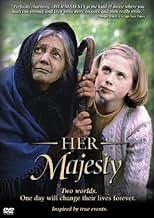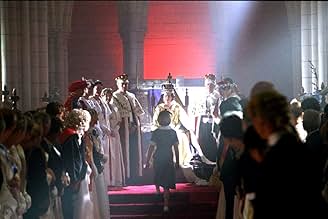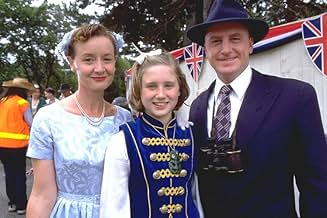Agrega una trama en tu idiomaThirteen-year-old Elizabeth's excitement about the Queen of England visiting her New Zealand town grows when she might meet her. As the town prepares, Elizabeth is drawn to the outcast elder... Leer todoThirteen-year-old Elizabeth's excitement about the Queen of England visiting her New Zealand town grows when she might meet her. As the town prepares, Elizabeth is drawn to the outcast elderly woman Hira.Thirteen-year-old Elizabeth's excitement about the Queen of England visiting her New Zealand town grows when she might meet her. As the town prepares, Elizabeth is drawn to the outcast elderly woman Hira.
- Dirección
- Guionista
- Elenco
- Premios
- 16 premios ganados y 5 nominaciones en total
Rachel Wallis
- Queen Elizabeth II
- (as Rachel E. Wallis)
- Dirección
- Guionista
- Todo el elenco y el equipo
- Producción, taquilla y más en IMDbPro
Argumento
¿Sabías que…?
- TriviaThe picture was nominated for 7 New Zealand Film and TV Awards in 2001 including Best Actress - Vicky Haughton, Best Juvenile Performer - Sally Andrews, Best Supporting Actress - Liddy Holloway and Best Contribution to a Soundtrack. In the end, movie won three gongs, which were for Best Design, Best Make Up and Best Costume Design.
- ConexionesReferences La princesa que quería vivir (1953)
- Bandas sonorasOrange Colored Sky
Written by Milton Delugg and Willie Stein
Opinión destacada
"Her Majesty" an impressive new film shown at the Mill Valley Film Festival.
For some time, there has been significant unrest with our entertainment media. Large segments of the public have been decrying Hollywood film productions. The choice of violent content, dysfunctional behavior, excessive sexual emphasis, and a debased human condition as subject material have championed sensationalism over the artistic potential of the film industry.
But there have been signs of a reawakening of the films artistry with a new generation of film makers. This example, a film made in New Zealand by a young American writer and director, Mark Gordon is one to stir nostalgia for this all but lost art.
The story line is a very straightforward one. A 12 year old girl, captivated by the fairytale like coronation of England's Queen Elizabeth in 1953 becomes obsessed with the notion that if she prevails on her Queen, often and with a great enough devotion, her idol might, on a tour of the Empire, come to New Zealand. Once there she would visit the small town of Middleton, where she might be met and greeted by this young dreamer. As a subplot, the great 19th century struggle by the Maori natives to keep the white man from killing their people and seizing their land is historically brought to life in the character of an old woman, daughter of a slain chief of the Maori who is befriended by our young dreamer. The few months between the Queen's itinerary being settled to include Middleton and the actual visit is a hectic melange of problems and resolutions that revolve about the girl's family, the Maori elder, and the community. The visit (which historically duplicates a real event in 1953, and includes locals who were present at that visit) calms all the ruffled waters and leaves the viewer teary eyed and fulfilled.
What then does one make of the wholesome content of this film, of the sensitive treatment of a child at the verge of her awakening as an adolescent and of her dreams. The film's depiction of the Maori elder's treatment as an outcast, and its reversal by the Queen is also developed with touching sensitivity. There is great care in dovetailing all of the above with great cinematography, a coordinated musical background, a precision of costume and period pieces of furniture and cars that blend together as great film artistry.
One leaves this film with a warm glow that is part nostalgia for simpler and less troubling times, and part hope for an industry to regain its focus, rekindling the art of filmaking to suggest that the human condition is not all bad. Art can reflect the best or the worst about us. It can also search for the simple but mysterious parts of ourselves and our world and express them in artistic metaphor.
This film does that beautifully. I hope it goes far, but if you get a chance, go see it , and take the kids.
For some time, there has been significant unrest with our entertainment media. Large segments of the public have been decrying Hollywood film productions. The choice of violent content, dysfunctional behavior, excessive sexual emphasis, and a debased human condition as subject material have championed sensationalism over the artistic potential of the film industry.
But there have been signs of a reawakening of the films artistry with a new generation of film makers. This example, a film made in New Zealand by a young American writer and director, Mark Gordon is one to stir nostalgia for this all but lost art.
The story line is a very straightforward one. A 12 year old girl, captivated by the fairytale like coronation of England's Queen Elizabeth in 1953 becomes obsessed with the notion that if she prevails on her Queen, often and with a great enough devotion, her idol might, on a tour of the Empire, come to New Zealand. Once there she would visit the small town of Middleton, where she might be met and greeted by this young dreamer. As a subplot, the great 19th century struggle by the Maori natives to keep the white man from killing their people and seizing their land is historically brought to life in the character of an old woman, daughter of a slain chief of the Maori who is befriended by our young dreamer. The few months between the Queen's itinerary being settled to include Middleton and the actual visit is a hectic melange of problems and resolutions that revolve about the girl's family, the Maori elder, and the community. The visit (which historically duplicates a real event in 1953, and includes locals who were present at that visit) calms all the ruffled waters and leaves the viewer teary eyed and fulfilled.
What then does one make of the wholesome content of this film, of the sensitive treatment of a child at the verge of her awakening as an adolescent and of her dreams. The film's depiction of the Maori elder's treatment as an outcast, and its reversal by the Queen is also developed with touching sensitivity. There is great care in dovetailing all of the above with great cinematography, a coordinated musical background, a precision of costume and period pieces of furniture and cars that blend together as great film artistry.
One leaves this film with a warm glow that is part nostalgia for simpler and less troubling times, and part hope for an industry to regain its focus, rekindling the art of filmaking to suggest that the human condition is not all bad. Art can reflect the best or the worst about us. It can also search for the simple but mysterious parts of ourselves and our world and express them in artistic metaphor.
This film does that beautifully. I hope it goes far, but if you get a chance, go see it , and take the kids.
- gbesson
- 6 feb 2002
- Enlace permanente
Selecciones populares
Inicia sesión para calificar y agrega a la lista de videos para obtener recomendaciones personalizadas
Detalles
- Fecha de lanzamiento
- País de origen
- Sitios oficiales
- Idioma
- También se conoce como
- Királynőpalánta
- Locaciones de filmación
- Cambridge, Waikato, Nueva Zelanda(setting: Middleton)
- Productora
- Ver más créditos de la compañía en IMDbPro
Taquilla
- Total en EE. UU. y Canadá
- USD 63,652
- Fin de semana de estreno en EE. UU. y Canadá
- USD 3,332
- 2 may 2004
- Total a nivel mundial
- USD 63,652
- Tiempo de ejecución1 hora 47 minutos
- Color
- Mezcla de sonido
Contribuir a esta página
Sugiere una edición o agrega el contenido que falta

Principales brechas de datos
By what name was Her Majesty (2001) officially released in India in English?
Responda













